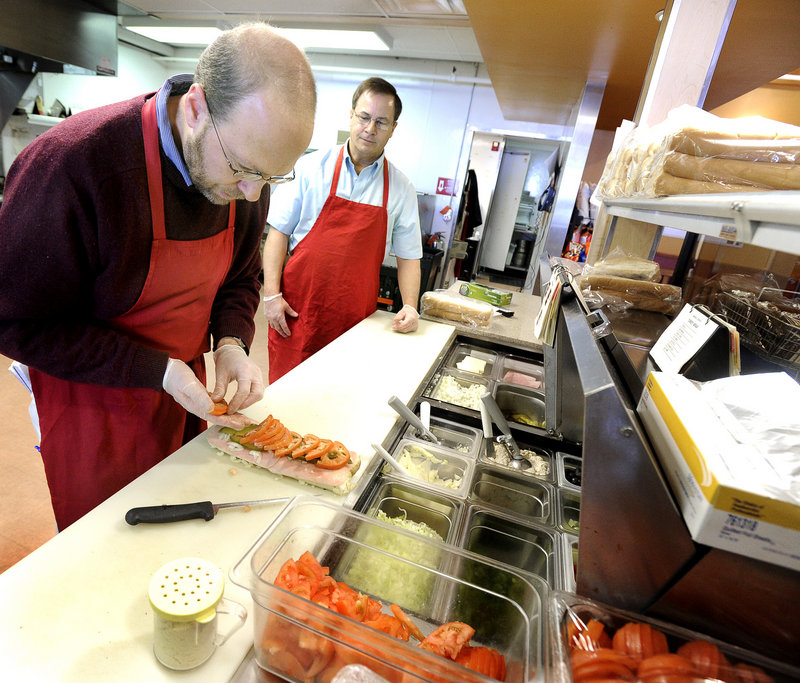FREEPORT – I’ve eaten enough Amato’s Italians in my time to feel confident that I would know exactly what went into one.
Until I had to make one for a customer.
How much ham? How much cheese? Which vegetables?
I was relieved when sandwich maker Brenda Billings showed me the little flip cards that list all of the ingredients of Amato’s sandwiches — and pizzas — along with the amount of each item.
But I got worried again when I realized how many variables there are for each sandwich.
Take this complicated scheme of variables for a “Real Italian,” Amato’s signature sandwich: A large gets three pieces of cheese and two pieces of meat, a handful of chopped onions, five or six slices of pickles, six to eight slices of green pepper, 10 to 12 slices of tomato and a handful of Greek olives.
But if the customer only wants two or fewer types of vegetables, they get six slices of cheese and four pieces of meat. For a small, the variables are two pieces of cheese and one and a half slices of meat, or four cheese and three meat if the veggie quotient is two or less.
Got it?
“I like having all this written down because it’s easier to keep straight,” said Billings, 34, of Durham.
I had to agree.
I was nervous enough making the Amato’s Real Italian, the sandwich that basically launched Amato’s in Portland in 1902. Today there are Amato’s locations and franchises all over Maine, as well as in a few other states.
Many people I know call Amato’s signature sandwich a “Maine Italian,” because it seems to be unique to this state. If you ask for an Italian in Boston, you get Italian cold cuts on crusty bread. At Amato’s, you get ham, American cheese, veggies and a specially blended oil on a very soft roll.
Right away, I learned some of the finer points of making an Amato’s Italian. First, I was told, slice the roll (for a large) along the side, not across the top. That allows the roll to open wider, to hold more.
Don’t skimp on the vegetables, especially the tomatoes. When the recipe called for 10 to 12 slices of tomatoes, I thought it was a misprint. But somehow I made them all fit.
And don’t skimp on the oil. At first I squirted just a little on top, not wanting to make the sandwich too messy. But Steve Shea, director of operations for the Amato’s franchise in Freeport, told me not to worry about messy.
“Hold the bottle straight up and be very liberal with it,” said Shea. “If Dominic Reali (Amato’s longtime owner) was here, he’d use half that bottle.”
Then I wrapped the sandwich in waxed paper, following the specific instructions the other sandwich makers gave me: Wrap the paper over the sandwich once, tuck it under, then cut the sandwich in half with a knife. Then fold the ends in and roll the sandwich over, then tape the waxed paper closed.
Luckily for me, the Freeport Amato’s franchise has employees cut vegetables before the lunch rush. Some Amato’s locations — mostly corporate ones — have employees cut veggies as they make sandwiches. All I had to do was pick up handfuls and put them on the sandwich.
When the lunch rush began, I went across the kitchen to help Billings with some of the hot foods. I made a pazzo bread, which I had never heard of, by spreading a garlic-butter mixture on dough and topping it with cheese before putting it in the oven.
I made a small pepperoni pizza by following the printed instructions for the sauce and cheese and pepperoni. It was one ladle full of sauce, 3½ ounces of cheese and 20 pieces of pepperoni.
I looked at the pizza, the size of a dinner plate, and couldn’t figure out how to get 20 pieces on there. My first mistake was taking the pieces, one at a time, from a little bin. I quickly realized it would be better to take a handful (I was wearing gloves the whole time) of pepperoni and count the slices out from my hand.
I got 17 pieces on before the pizza looked full. Ann Hart, the manager, told me to spread them out more and not be afraid to cover the whole pizza, all the way to the edges.
“Because you want pepperoni in that very last bite,” said Hart. “At least I do.”
I also, at various points, helped make cannoli, as well as eggplant parmigiana sandwiches. The eggplant sandwiches had to be baked in a specific part of the oven — marked off with a piece of tape — so they wouldn’t burn.
Working around the oven was a little difficult, because I smelled melting cheese at all times.
“Yeah, that can make you hungry,” said Billings.
Staff Writer Ray Routhier can be contacted at 791-6454 or at:
rrouthier@pressherald.com
Send questions/comments to the editors.



